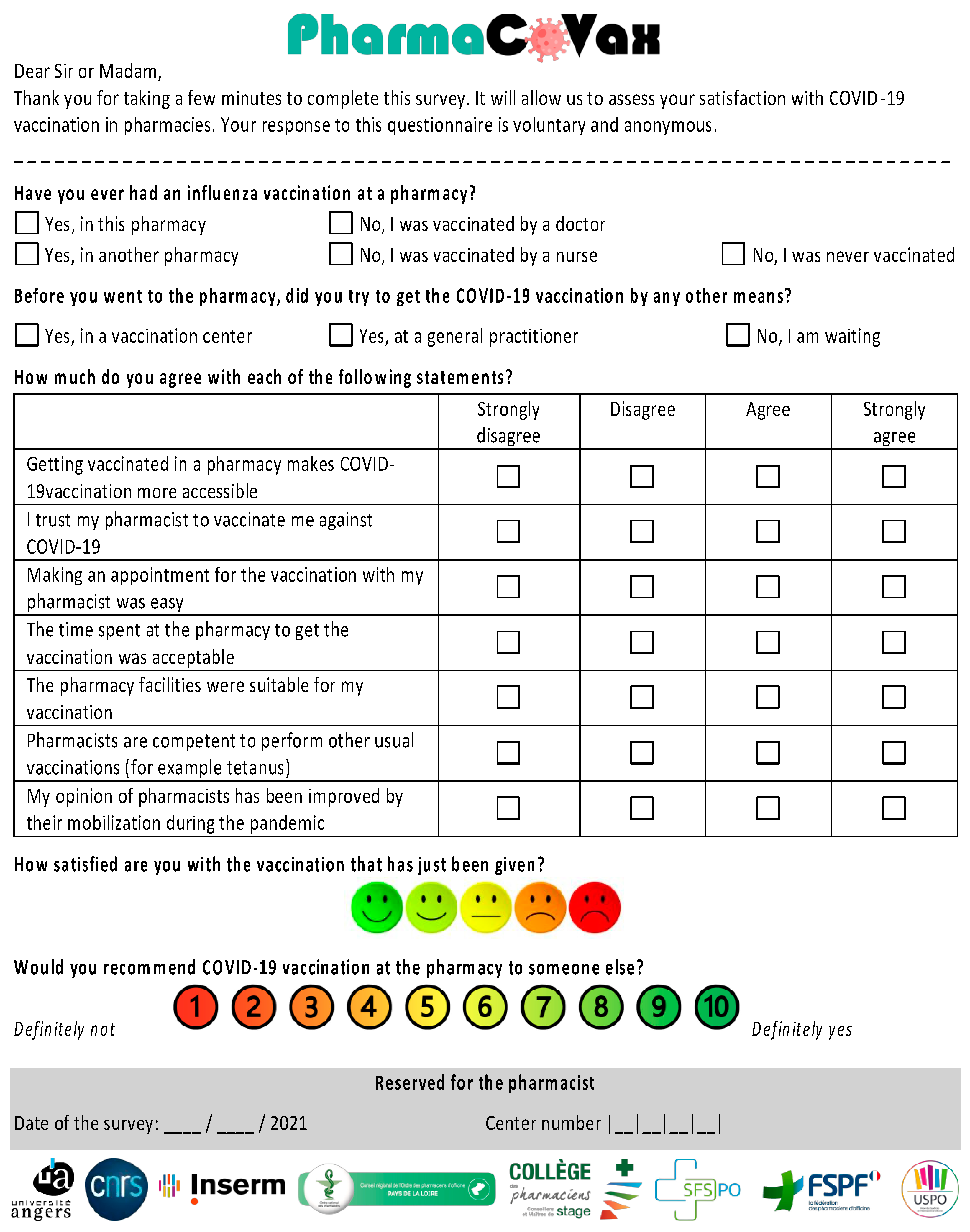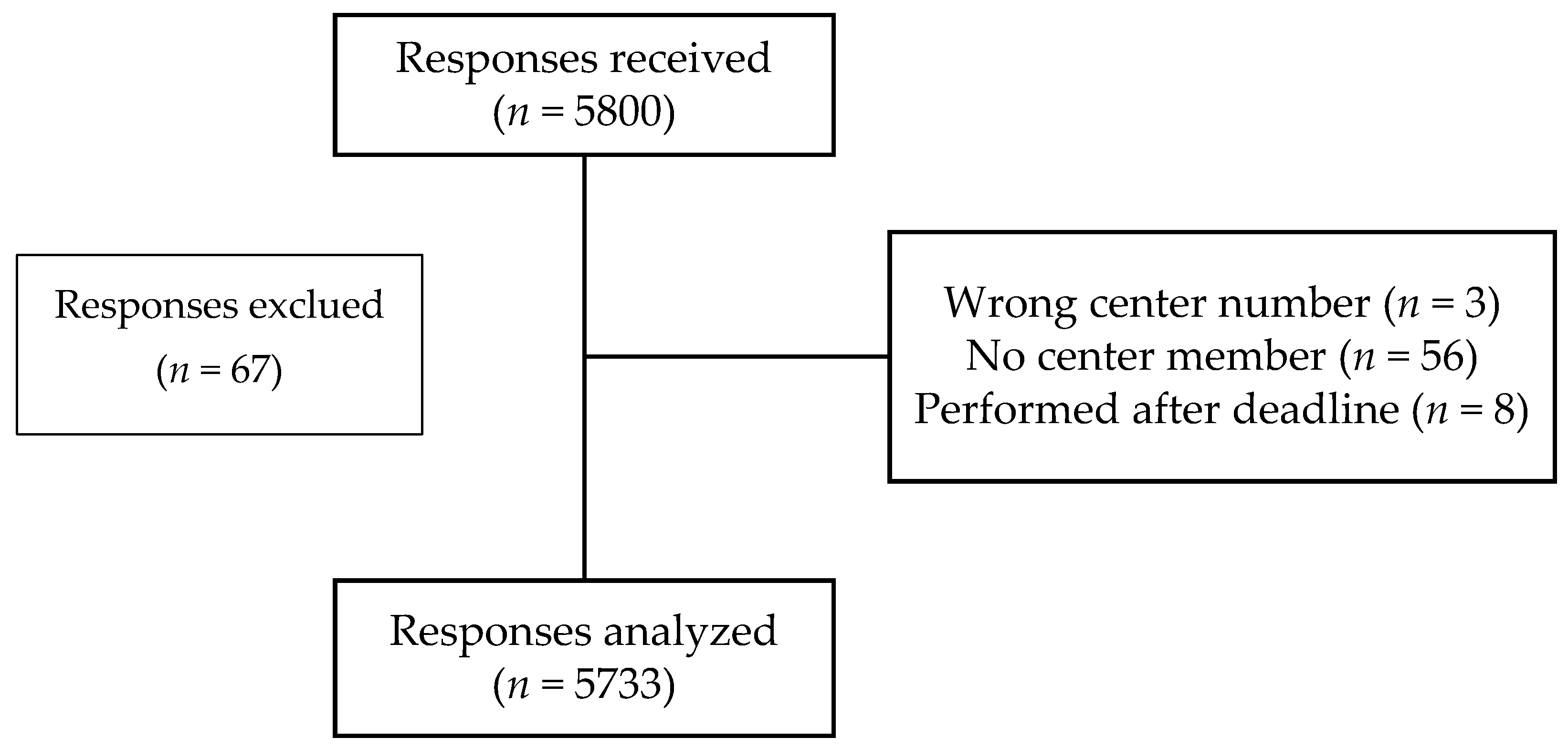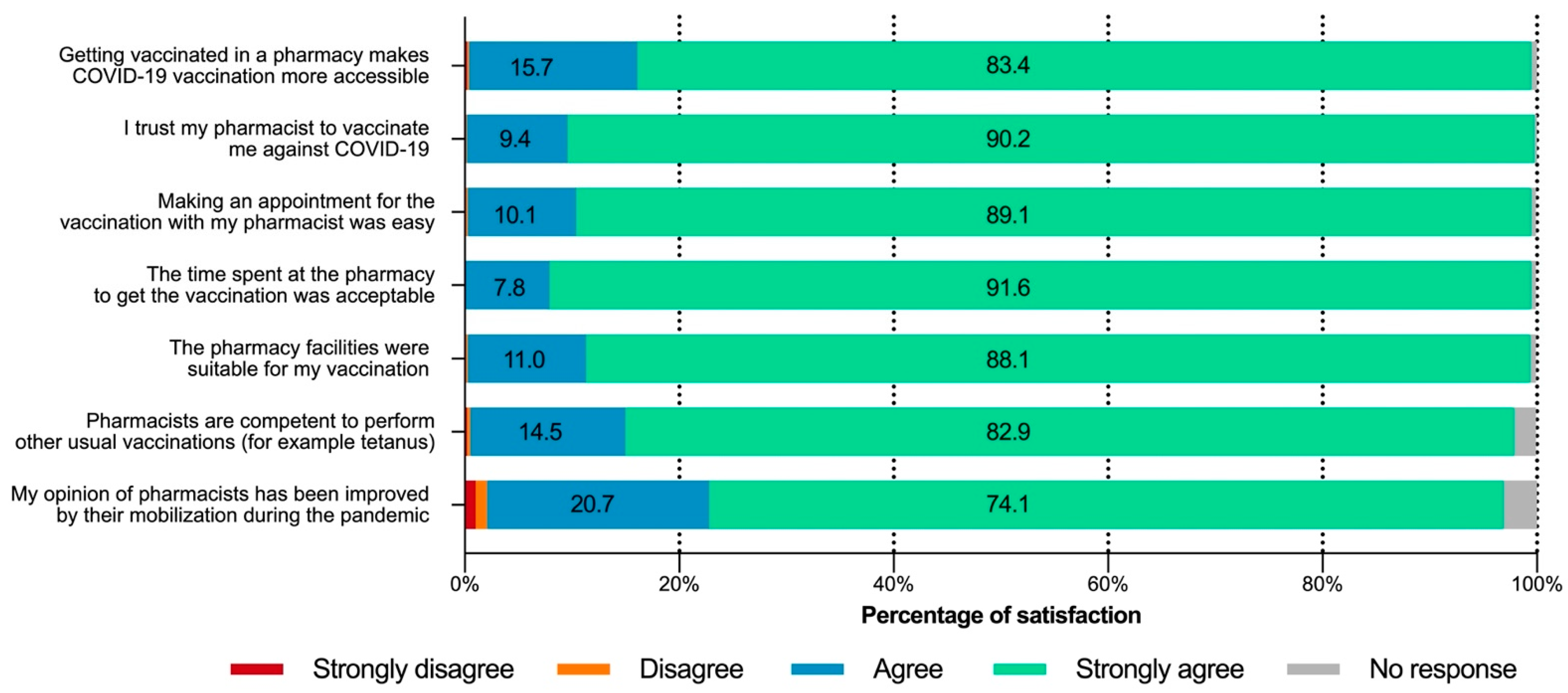Assessment of Satisfaction with Pharmacist-Administered COVID-19 Vaccinations in France: PharmaCoVax
Abstract
:1. Introduction
2. Materials and Methods
2.1. Community Pharmacist Involvement
2.2. Respondent Recruitment
- From 16 March to 10 April (people over 55 years old, with comorbidities).
- From 11 April to 30 April (people over 55 years old, with or without comorbidities).
- From 1 May to 30 May (people over 18 years old, with comorbidities and all people over 55 years old).
- From 31 May to 30 June (people over 18 years old, with or without comorbidities).
2.3. Data Collection
2.4. Statistical Analysis
3. Results
3.1. Community Pharmacy Characteristics
3.2. Survey Data: Descriptive Analysis
3.2.1. Characteristics of PharmaCoVax Survey Respondents
3.2.2. Respondent Opinions Regarding Pharmacist Involvement in the Vaccination Program
3.2.3. Respondent Satisfaction
3.3. Survey Data: Comparative Analysis
3.3.1. Respondent Characteristics Depending on Survey Period
3.3.2. Respondent Opinions Depending on Survey Period
3.3.3. Respondent Opinion Depending on Previous Influenza Vaccination
3.3.4. Respondent Satisfaction and Likelihood of Recommendation Depending on Survey Period
4. Discussion
5. Conclusions
Supplementary Materials
Author Contributions
Funding
Institutional Review Board Statement
Informed Consent Statement
Data Availability Statement
Acknowledgments
Conflicts of Interest
Appendix A

Appendix B

References
- Peretti-Watel, P.; Seror, V.; Cortaredona, S.; Launay, O.; Raude, J.; Verger, P.; Fressard, L.; Beck, F.; Legleye, S.; L’Haridon, O.; et al. A Future Vaccination Campaign against COVID-19 at Risk of Vaccine Hesitancy and Politicisation. Lancet Infect. Dis. 2020, 20, 769–770. [Google Scholar] [CrossRef]
- Taylor, S.; Landry, C.A.; Paluszek, M.M.; Groenewoud, R.; Rachor, G.S.; Asmundson, G.J.G. A Proactive Approach for Managing COVID-19: The Importance of Understanding the Motivational Roots of Vaccination Hesitancy for SARS-CoV2. Front. Psychol. 2020, 11, 575950. [Google Scholar] [CrossRef] [PubMed]
- Thunstrom, L.; Ashworth, M.; Finnoff, D.; Newbold, S. Hesitancy Towards a COVID-19 Vaccine and Prospects for Herd Immunity; Social Science Research Network: Rochester, NY, USA, 2020. [Google Scholar]
- Sallam, M. COVID-19 Vaccine Hesitancy Worldwide: A Concise Systematic Review of Vaccine Acceptance Rates. Vaccines 2021, 9, 160. [Google Scholar] [CrossRef]
- Feleszko, W.; Lewulis, P.; Czarnecki, A.; Waszkiewicz, P. Flattening the Curve of COVID-19 Vaccine Rejection-An International Overview. Vaccines 2021, 9, 44. [Google Scholar] [CrossRef]
- Ritchie, H.; Mathieu, E.; Rodés-Guirao, L.; Appel, C.; Giattino, C.; Ortiz-Ospina, E.; Hasell, J.; Macdonald, B.; Beltekian, D.; Roser, M. Coronavirus Pandemic (COVID-19). Our World Data. 2020. Available online: https://ourworldindata.org/coronavirus (accessed on 24 January 2022).
- Arrêté Du 23 Avril 2019 Fixant La Liste Des Vaccinations Que Les Pharmaciens d’officine Peuvent Effectuer En Application Du 9° de l’article L. 5125-1-1 A Du Code de La Santé Publique. Available online: https://www.legifrance.gouv.fr/loda/id/JORFTEXT000038409906/ (accessed on 14 November 2021).
- Caisse Nationale de l’Assurance Maladie Bilan Intermédiaire de la Vaccination Antigrippale des Officines. Available online: https://www.data.gouv.fr/en/organizations/caisse-nationale-de-l-assurance-maladie-des-travailleurs-salaries/ (accessed on 3 January 2022).
- Décret N° 2021-248 Du 4 Mars 2021 Modifiant Les Décrets N° 2020-1262 Du 16 Octobre 2020 et N° 2020-1310 Du 29 Octobre 2020 Prescrivant Les Mesures Générales Nécessaires Pour Faire Face à l’épidémie de Covid-19 Dans Le Cadre de l’état d’urgence Sanitaire—Légifrance. Available online: https://www.legifrance.gouv.fr/jorf/id/JORFTEXT000043216584 (accessed on 7 March 2021).
- Arrêté Du 3 Novembre 2021 Modifiant l’arrêté Du 1er Juin 2021 Prescrivant Les Mesures Générales Nécessaires à La Gestion de La Sortie de Crise Sanitaire. Available online: https://www.legifrance.gouv.fr/jorf/id/JORFTEXT000044287441 (accessed on 24 January 2022).
- Arrêté Du 29 Novembre 2021 Modifiant l’arrêté Du 1er Juin 2021 Prescrivant Les Mesures Générales Nécessaires à La Gestion de La Sortie de Crise Sanitaire. Available online: https://www.legifrance.gouv.fr/jorf/id/JORFTEXT000044384921 (accessed on 24 January 2022).
- Union des Syndicats de Pharmaciens d’Officine, USPO. Available online: https://uspo.fr/ (accessed on 16 January 2022).
- Fédération des Syndicats Pharmaceutiques de France, FSPF. Available online: http://www.fspf.fr/ (accessed on 16 January 2022).
- IQVIA COVID19: Suivi de La Vaccination En Officine. Available online: https://iqvia.opendatasoft.com/pages/vaccination/ (accessed on 3 January 2022).
- Leroy, E. Pharmacies: Moyennes Professionnelles 2021; KPMG: Amstelveen, The Netherlands, 2021; p. 56. [Google Scholar]
- Lee, S. Net Promoter Score: Using NPS to Measure IT Customer Support Satisfaction; Assoc Computing Machinery: New York, NY, USA, 2018; pp. 63–64. ISBN 978-1-4503-5582-7. [Google Scholar]
- Laitinen, M.A. Fix, Develop, Keep! Qual. Quant. Methods Libr. 2019, 8, 147–158. [Google Scholar]
- Hamilton, D.F.; Lane, J.V.; Gaston, P.; Patton, J.T.; MacDonald, D.J.; Simpson, A.H.R.W.; Howie, C.R. Assessing Treatment Outcomes Using a Single Question The Net Promoter Score. Bone Jt. J. 2014, 96B, 622–628. [Google Scholar] [CrossRef] [Green Version]
- Institut National de la Statistique et des Etudes Economiques Nombre D’équipements et de Services de Santé En 2020—Dénombrement Des Équipements En 2020 (Commerce, Services, Santé…). Insee. Available online: https://www.insee.fr/fr/statistiques/3568611?sommaire=3568656 (accessed on 25 October 2021).
- Ministère des Solidarités et de la Santé Grippe Saisonnière. Available online: https://solidarites-sante.gouv.fr/soins-et-maladies/maladies/maladies-infectieuses/les-maladies-de-l-hiver/grippe-saisonniere (accessed on 29 October 2021).
- Stämpfli, D.; Martinez-De la Torre, A.; Simi, E.; Du Pasquier, S.; Berger, J.; Burden, A.M. Community Pharmacist-Administered COVID-19 Vaccinations: A Pilot Customer Survey on Satisfaction and Motivation to Get Vaccinated. Vaccines 2021, 9, 1320. [Google Scholar] [CrossRef] [PubMed]
- Hattingh, H.L.; Sim, T.F.; Parsons, R.; Czarniak, P.; Vickery, A.; Ayadurai, S. Evaluation of the First Pharmacist-Administered Vaccinations in Western Australia: A Mixed-Methods Study. BMJ Open 2016, 6, e011948. [Google Scholar] [CrossRef] [Green Version]
- Burt, S.; Hattingh, L.; Czarniak, P. Evaluation of Patient Satisfaction and Experience towards Pharmacist-Administered Vaccination Services in Western Australia. Int. J. Clin. Pharm. 2018, 40, 1519–1527. [Google Scholar] [CrossRef]
- Isenor, J.E.; Wagg, A.C.; Bowles, S.K. Patient Experiences with Influenza Immunizations Administered by Pharmacists. Hum. Vaccines Immunother. 2018, 14, 706–711. [Google Scholar] [CrossRef]
- Elbeddini, A.; Prabaharan, T.; Almasalkhi, S.; Tran, C. Pharmacists and COVID-19. J. Pharm. Policy Pract. 2020, 13, 36. [Google Scholar] [CrossRef]
- Merks, P.; Jakubowska, M.; Drelich, E.; Świeczkowski, D.; Bogusz, J.; Bilmin, K.; Sola, K.F.; May, A.; Majchrowska, A.; Koziol, M.; et al. The Legal Extension of the Role of Pharmacists in Light of the COVID-19 Global Pandemic. Res. Soc. Adm. Pharm. 2021, 17, 1807–1812. [Google Scholar] [CrossRef] [PubMed]
- Stoecker, C. Shooting from the ‘Scrip: Scope of Practice Laws and Access to Immunizations in the Pharmacy Setting. Vaccines 2021, 9, 444. [Google Scholar] [CrossRef]
- Beal, J.L.; Kadakia, N.N.; Reed, J.B.; Illingworth Plake, K.S. Pharmacists’ Impact on Older Adults’ Access to Vaccines in the United States. Vaccine 2020, 38, 2456–2465. [Google Scholar] [CrossRef] [PubMed]
- Santé Publique France CoviPrev: Une Enquête pour Suivre L’évolution des Comportements et de la Santé Mentale Pendant L’épidémie de COVID-19. Available online: https://www.santepubliquefrance.fr/etudes-et-enquetes/coviprev-une-enquete-pour-suivre-l-evolution-des-comportements-et-de-la-sante-mentale-pendant-l-epidemie-de-covid-19 (accessed on 6 October 2021).
- Fisk, R.J. Barriers to Vaccination for Coronavirus Disease 2019 (COVID-19) Control: Experience from the United States. Glob. Health J. Amst. Neth. 2021, 5, 51–55. [Google Scholar] [CrossRef] [PubMed]
- Ministère des Solidarité et de la Santé Le tableau de Bord de la Vaccination. Available online: https://solidarites-sante.gouv.fr/grands-dossiers/vaccin-covid-19/article/le-tableau-de-bord-de-la-vaccination (accessed on 17 February 2022).
- Marwitz, K.K. The Pharmacist’s Active Role in Combating COVID-19 Medication Misinformation. J. Am. Pharm. Assoc. 2021, 61, e71–e74. [Google Scholar] [CrossRef]
- Gautier, A.; Verger, P.; Jestin, C. Sources d’information, opinions et pratiques des parents en matière de vaccination en France en 2016. Bull. Epidémiol. Hebd. 2017, 28, 28–35. [Google Scholar] [CrossRef]
- Jacob, S.S.; Bridgeman, M.B.; Kim, H.; Toscani, M.; Kohler, R.; Shiau, S.; Jimenez, H.R.; Barone, J.A.; Narayanan, N. Pharmacists’ Perceptions and Drivers of Immunization Practices for COVID-19 Vaccines: Results of a Nationwide Survey Prior to COVID-19 Vaccine Emergency Use Authorization. Pharm. J. Pharm. Educ. Pract. 2021, 9, 131. [Google Scholar] [CrossRef]
- Gagneux-Brunon, A.; Detoc, M.; Bruel, S.; Tardy, B.; Rozaire, O.; Frappe, P.; Botelho-Nevers, E. Intention to Get Vaccinations against COVID-19 in French Healthcare Workers during the First Pandemic Wave: A Cross-Sectional Survey. J. Hosp. Infect. 2021, 108, 168–173. [Google Scholar] [CrossRef]
- Caisse Nationale de l’Assurance Maladie Données Vaccination par Catégorie D’injecteur, hors Centres de Vaccination et Etablissements de Santé. Available online: https://datavaccin-covid.ameli.fr/explore/dataset/donnees-de-vaccination-type-dinjecteur/ (accessed on 6 October 2021).
- Paudyal, V.; Fialová, D.; Henman, M.C.; Hazen, A.; Okuyan, B.; Lutters, M.; Cadogan, C.; da Costa, F.A.; Galfrascoli, E.; Pudritz, Y.M.; et al. Pharmacists’ Involvement in COVID-19 Vaccination across Europe: A Situational Analysis of Current Practice and Policy. Int. J. Clin. Pharm. 2021, 43, 1139–1148. [Google Scholar] [CrossRef] [PubMed]
- Bragazzi, N.L. Pharmacists as Immunizers: The Role of Pharmacies in Promoting Immunization Campaigns and Counteracting Vaccine Hesitancy. Pharmacy 2019, 7, 166. [Google Scholar] [CrossRef] [PubMed] [Green Version]
- Richardson, W.M.; Wertheimer, A.I. A Review of the Pharmacist as Vaccinator. Innov. Pharm. 2019, 10, 3. [Google Scholar] [CrossRef] [PubMed] [Green Version]




| Region | Participating Pharmacy Sample (%) | INSEE Data (%) 1 |
| Auvergne-Rhône-Alpes | 5 (4.1) | 2552 (11.8) |
| Bourgogne-Franche-Comté | 11 (8.9) | 975 (4.5) |
| Brittany | 8 (6.5) | 1052 (4.9) |
| Central France—Loire Valley | 1 (0.8) | 806 (3.7) |
| Corsica | 0 (0.0) | 135 (0.6) |
| Grand-Est | 24 (19.5) | 1630 (7.6) |
| Hauts-de-France | 22 (17.9) | 2020 (9.4) |
| Ile-de-France | 6 (4.9) | 3631 (16.8) |
| Normandy | 0 (0.0) | 969 (4.5) |
| New Aquitaine | 4 (3.3) | 2143 (9.9) |
| Occitania | 18 (14.6) | 2037 (9.4) |
| Loire | 23 (18.7) | 1123 (5.2) |
| Provence-Alpes-Côte d’Azur | 1 (0.8) | 1896 (8.8) |
| Overseas | 0 (0.0) | 611 (2.8) |
| Total | 123 (100.0) | 21,580 (100.0) |
| Pharmacy location | Participating pharmacy sample (%) | KPMG data (%) 2 |
| Rural | 66 (53.6) | 226 (36.8) |
| Urban | 52 (42.3) | 351 (57.3) |
| Shopping center | 5 (4.1) | 37 (5.9) |
| Total | 123 (100.0) | 614 (100.0) |
| Annual turnover | Participating pharmacy sample (%) | KPMG data (%) 2 |
| < EUR 1100 k | 23 (18.7) | 148 (24.0) |
| EUR 1100–2200 k | 68 (55.3) | 308 (50.2) |
| > EUR 2200 k | 32 (26.0) | 158 (25.8) |
| Total | 123 (100.0) | 614 (100.0) |
| Number of vaccinators | Participating pharmacy sample (%) | National data (%) |
| 1 | 12 (9.8) | NA |
| 2 | 60 (48.7) | NA |
| 3 | 39 (31.7) | NA |
| 4 or more | 12 (9.8) | NA |
| Total | 123 (100.0) | NA |
| Previous influenza Vaccination * | Frequency (%) |
| Flu vaccination in the same pharmacy | 1744 (30.4) |
| Flu vaccination in another pharmacy | 175 (3.1) |
| Flu vaccination outside pharmacy | 1469 (25.6) |
| Never received flu vaccination | 2138 (37.3) |
| No response | 207 (3.6) |
| Attempted COVID-19 vaccination | Frequency (%) |
| Attempt at a general practitioner (GP) | 603 (10.5) |
| Attempt in a vaccination center (VC) | 638 (11.1) |
| Attempt at a GP and in a VC | 129 (2.3) |
| No attempt | 1897 (68.0) |
| No response | 466 (8.1) |
| Satisfaction | Sample Size | Respondents (%) | Mean | SD |
| Period 1 | 2023 | 1880 (90.9) | 4.932 | 0.274 |
| Period 2 | 2024 | 1840 (92.4) | 4.926 | 0.275 |
| Period 3 | 903 | 834 (94.9) | 4.897 | 0.345 |
| Period 4 | 783 | 743 (92.4) | 4.891 | 0.337 |
| All periods | 5733 | 5297 (92.9) | 4.918 | 0.296 |
| Recommendation | Sample size | Promotors, % | Detractors, % | NPS, % |
| Period 1 | 1903 | 94.5 | 0.4 | 94.2 |
| Period 2 | 1896 | 94.4 | 0.6 | 93.8 |
| Period 3 | 860 | 92.8 | 0.6 | 92.2 |
| Period 4 | 750 | 92.4 | 1.3 | 91.1 |
| All periods | 5409 | 93.9 | 0.6 | 93.3 |
Publisher’s Note: MDPI stays neutral with regard to jurisdictional claims in published maps and institutional affiliations. |
© 2022 by the authors. Licensee MDPI, Basel, Switzerland. This article is an open access article distributed under the terms and conditions of the Creative Commons Attribution (CC BY) license (https://creativecommons.org/licenses/by/4.0/).
Share and Cite
Piraux, A.; Cavillon, M.; Ramond-Roquin, A.; Faure, S. Assessment of Satisfaction with Pharmacist-Administered COVID-19 Vaccinations in France: PharmaCoVax. Vaccines 2022, 10, 440. https://doi.org/10.3390/vaccines10030440
Piraux A, Cavillon M, Ramond-Roquin A, Faure S. Assessment of Satisfaction with Pharmacist-Administered COVID-19 Vaccinations in France: PharmaCoVax. Vaccines. 2022; 10(3):440. https://doi.org/10.3390/vaccines10030440
Chicago/Turabian StylePiraux, Arthur, Marie Cavillon, Aline Ramond-Roquin, and Sébastien Faure. 2022. "Assessment of Satisfaction with Pharmacist-Administered COVID-19 Vaccinations in France: PharmaCoVax" Vaccines 10, no. 3: 440. https://doi.org/10.3390/vaccines10030440
APA StylePiraux, A., Cavillon, M., Ramond-Roquin, A., & Faure, S. (2022). Assessment of Satisfaction with Pharmacist-Administered COVID-19 Vaccinations in France: PharmaCoVax. Vaccines, 10(3), 440. https://doi.org/10.3390/vaccines10030440






